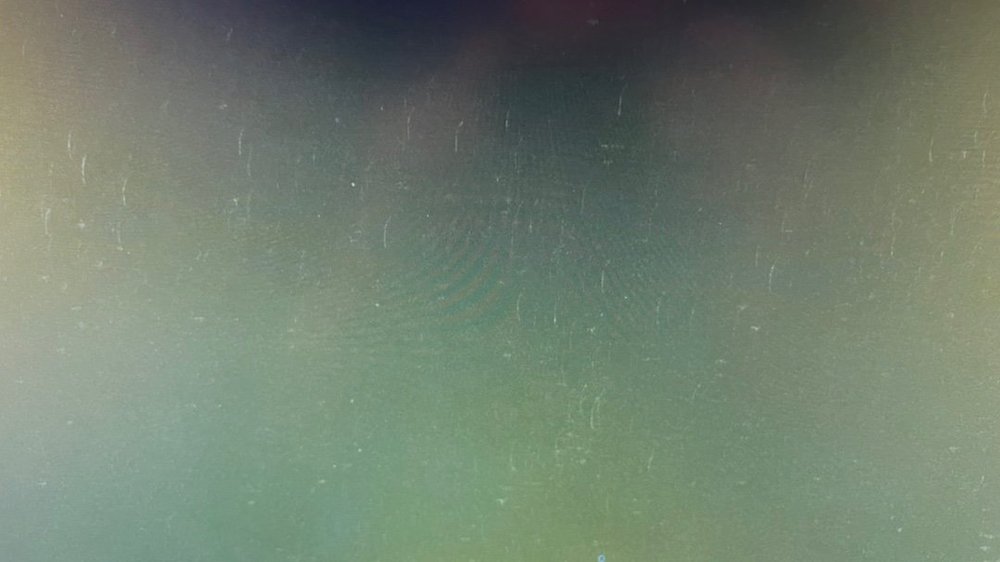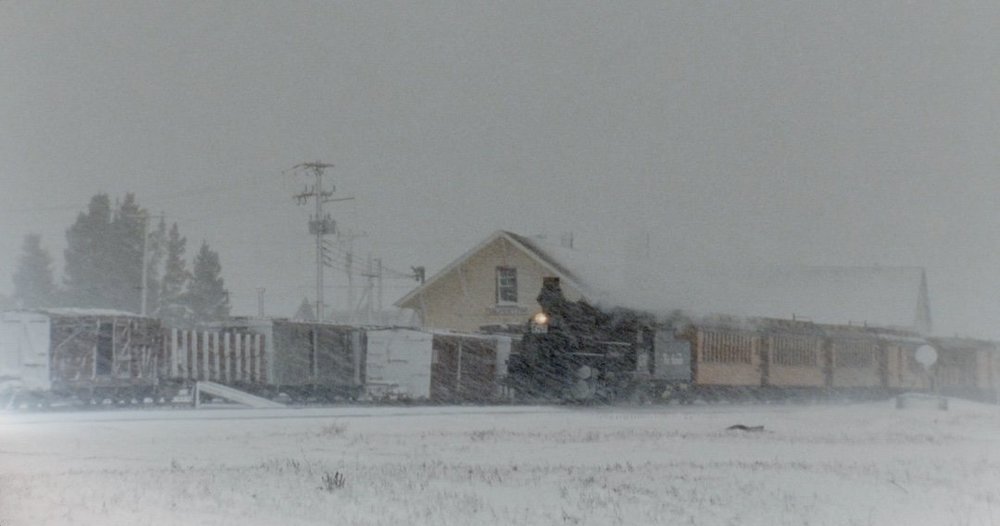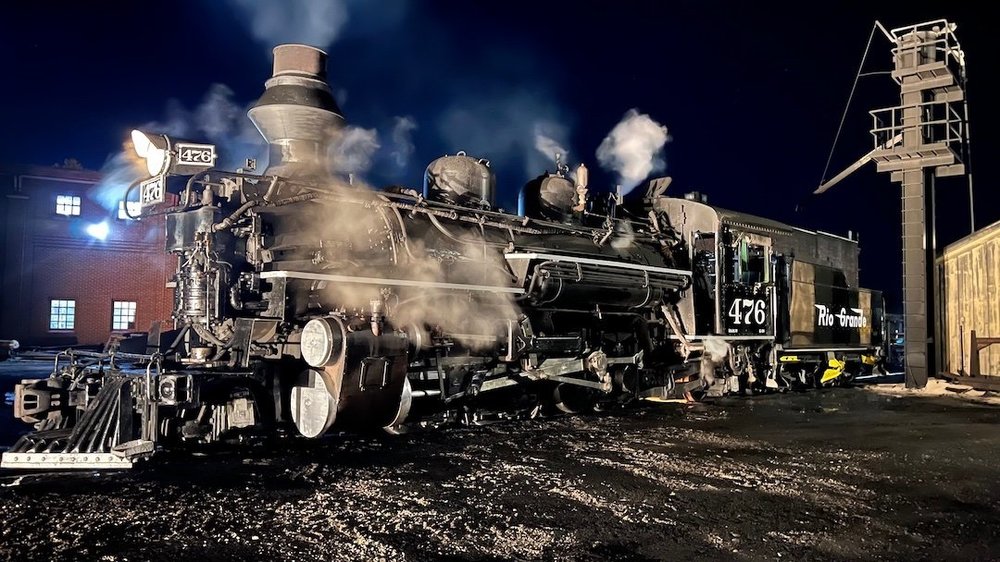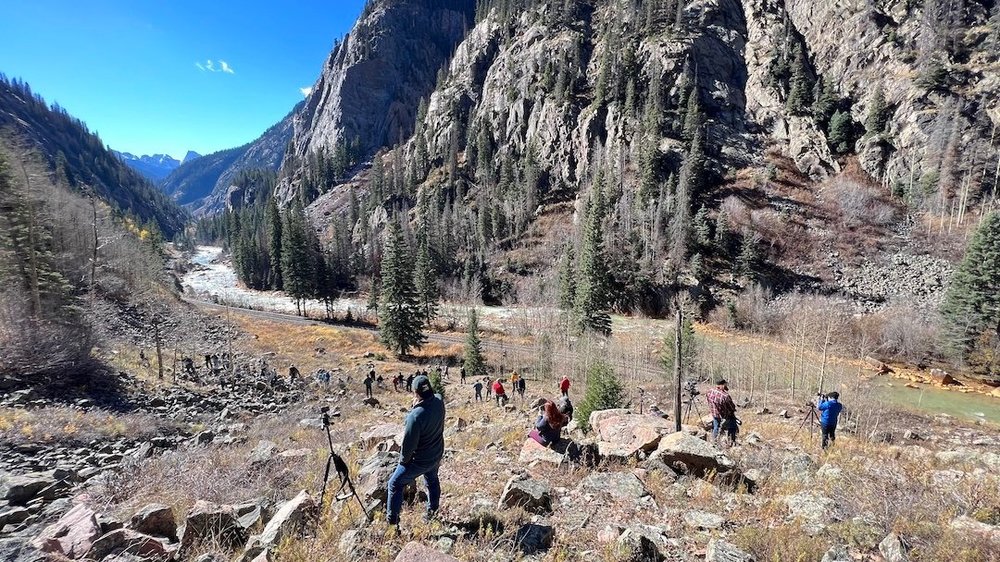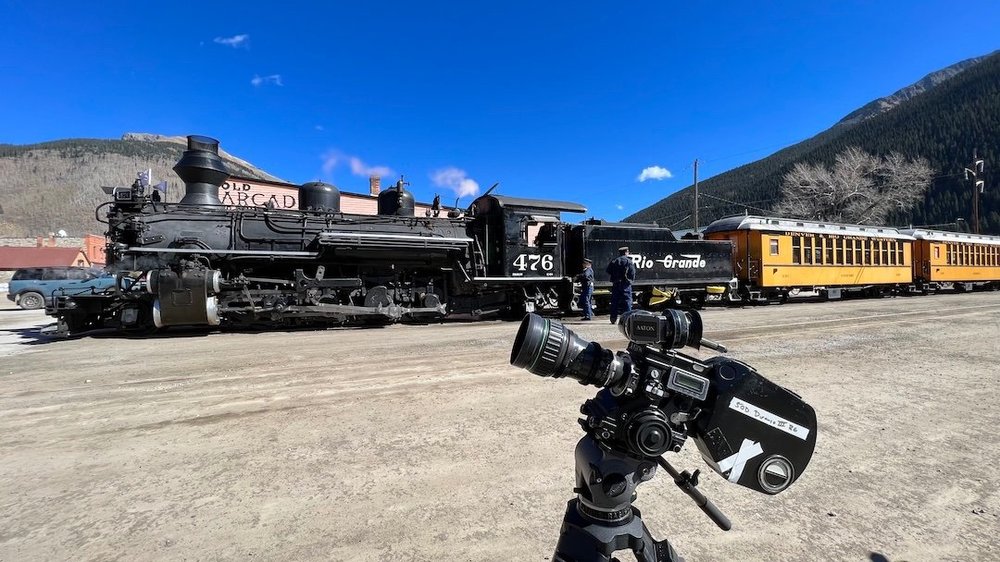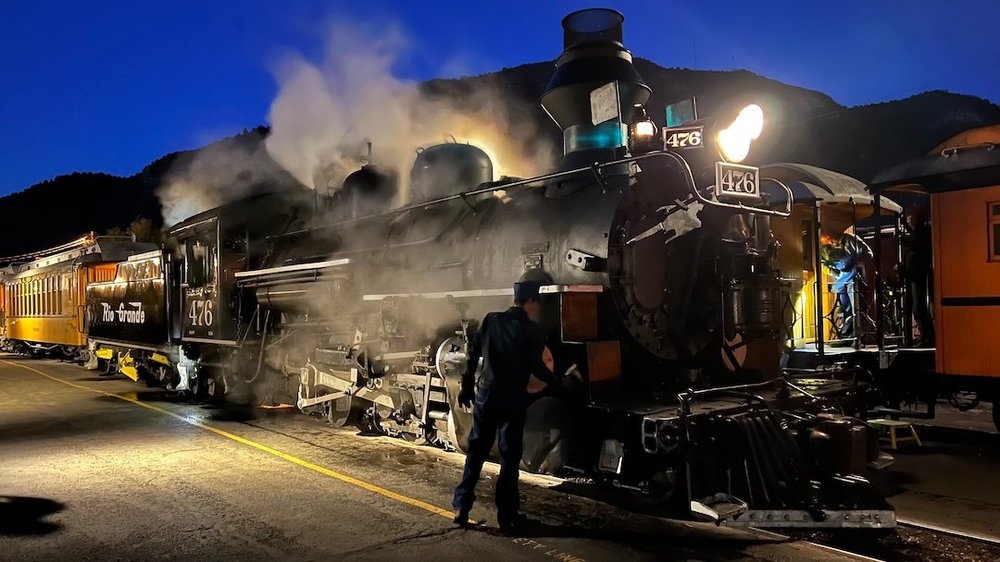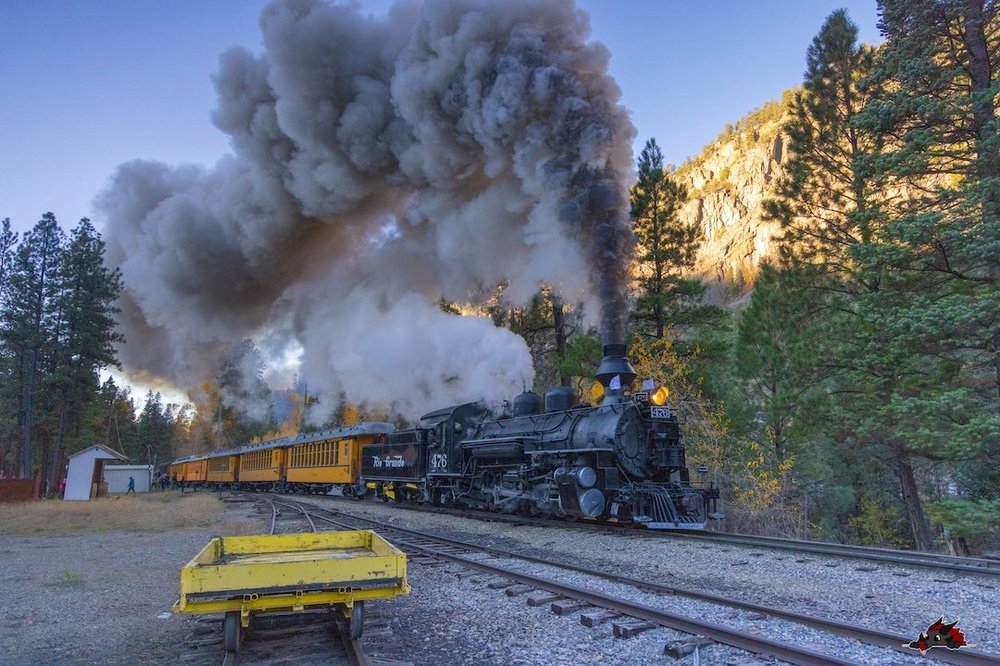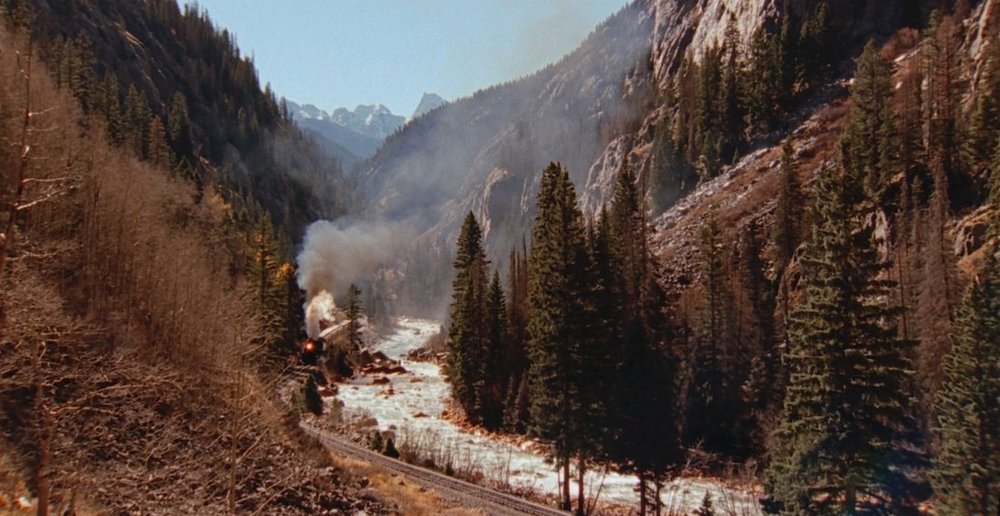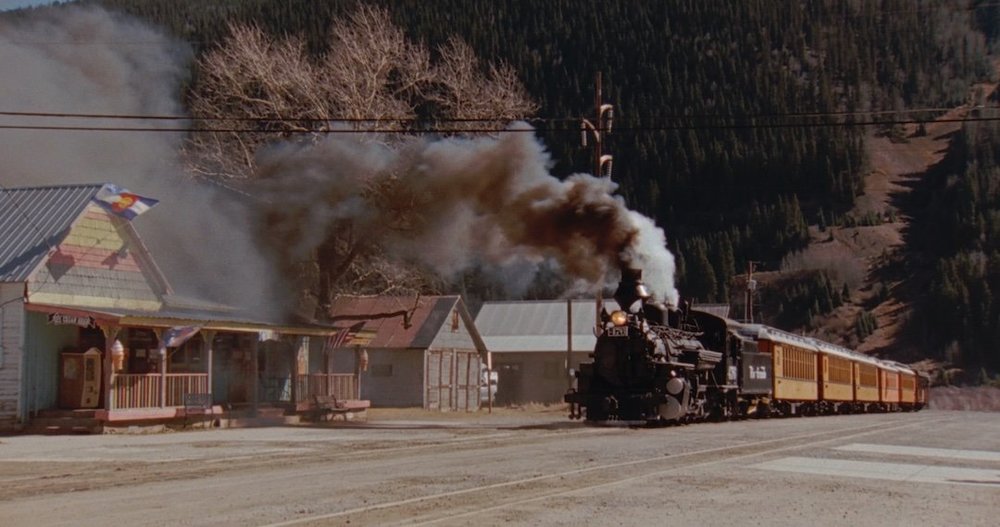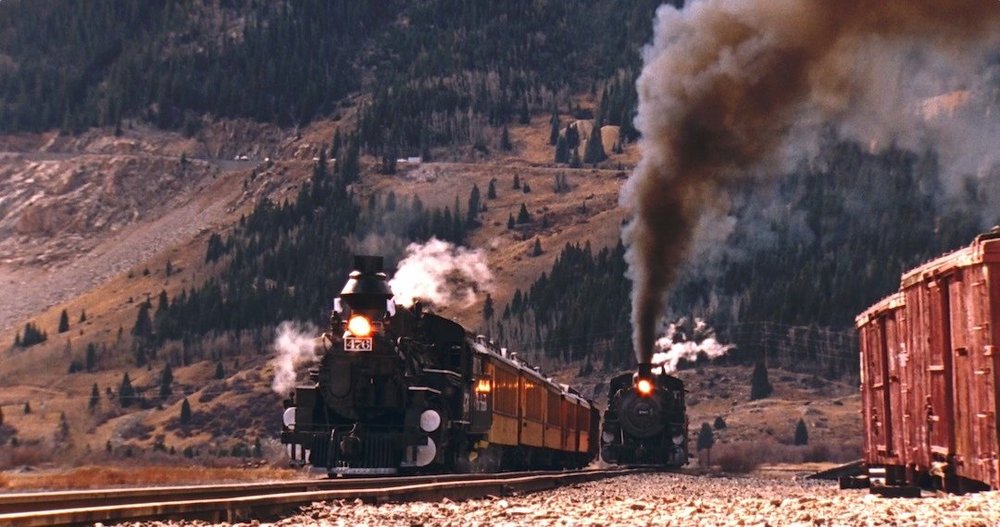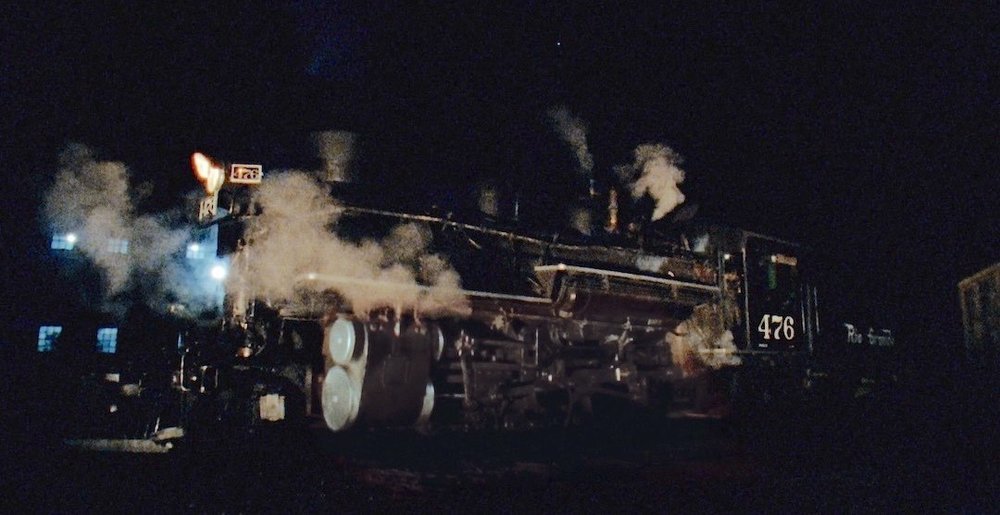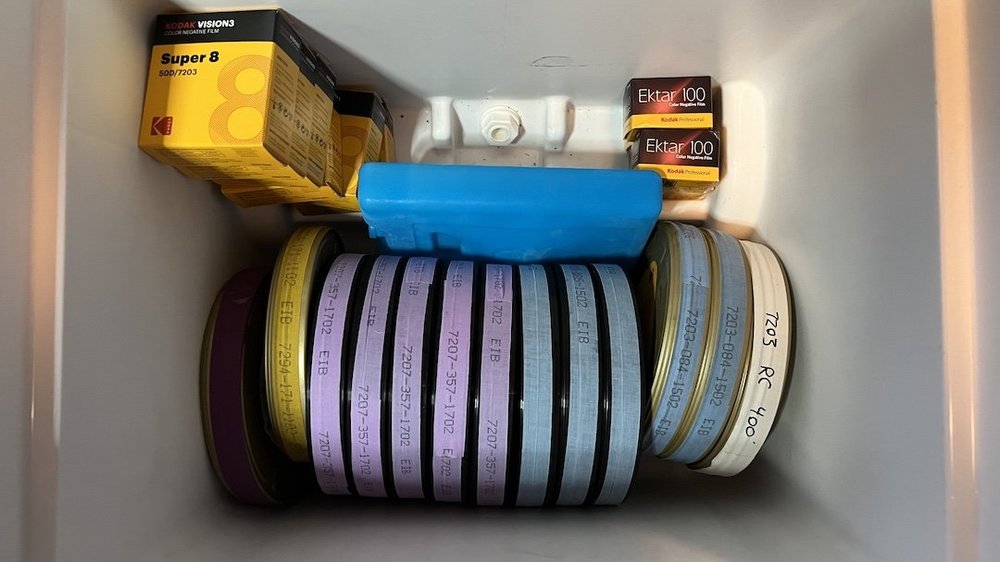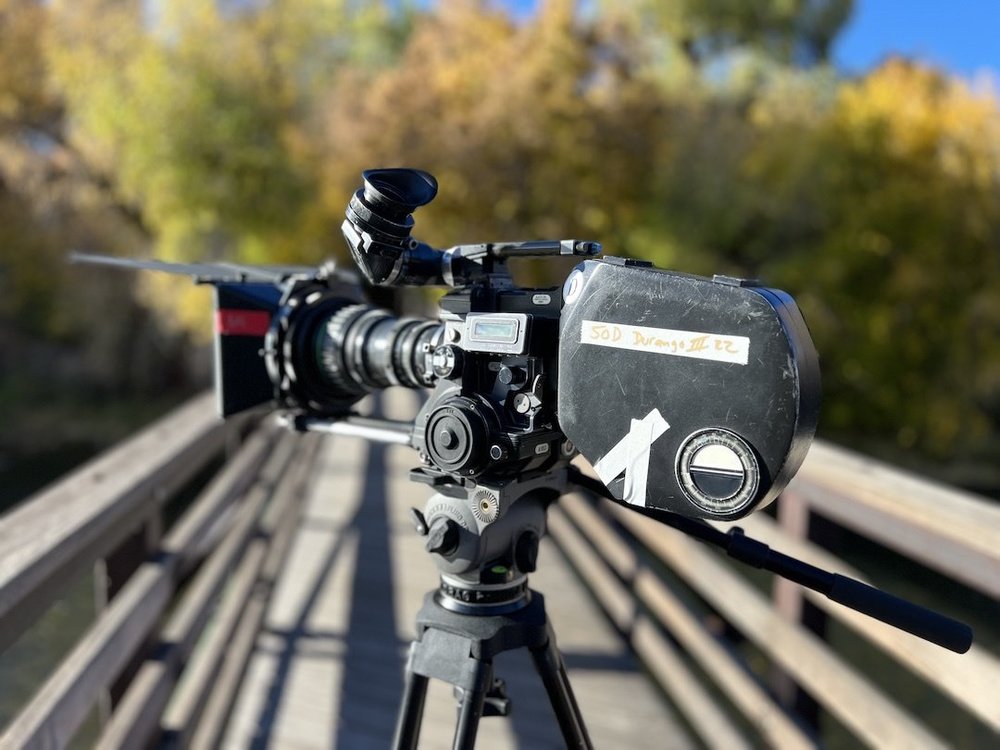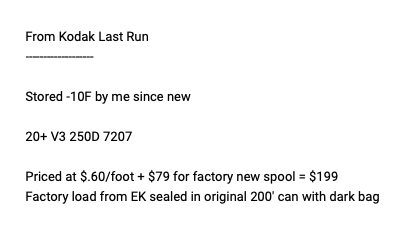-
Posts
7,485 -
Joined
-
Last visited
Everything posted by Tyler Purcell
-
Our final day was met with a winter storm. Durango was beautiful weather, but Silverton was snowing. We decided to take the trek over to Silverton and get some shots of the train. This was unscripted, totally freak storm and it fit in so well with our story. We got very lucky and the railroad ran the same engine 476 that day, even though it wasn’t a special photography train. So the idea was to shoot similar framing from the day before, so we could show some contrast between a beautiful sunny, golden leaves day, to a snow storm. Unfortunately we did not bring the right clothes with us and it was damn cold. So the best I could do was one similar framed shot of the depot. This worked perfectly and in the film its one of the highlight transitions. We shot a few more quick shots and man, they all came out great, even though I was frozen solid and so was my poor camera. Getting back to Durango during the storm was like living in Boston again, visibility was very poor, but our BMW X5 with X drive did a great job, even with all weather tires. (Getting a close-up of the cab) (476 as it wades through the snow) But that sadly ended our quick trip and the following day, we headed home and straight to Fotokem for processing. When we received the film back the following day and threw it on the scanner, I noticed something horribly wrong. There was a waterfall effect in many shots, looked like micro cinching, something I had never seen before. I talked to Mark over at Fotokem and he didn’t really understand the problem. I was furious because some of the best shots of our 9 roll shoot, were entirely covered in this pattern, which made them useless in my eyes. I tried fixing it digitally with Resolve and our first edit had those fixed shots, but it removed the grain entirely and any motion looked weird. It was so sad and incredibly frustrating. I reached out to a few people and they suggested using a restoration software like DVO Phoenix and that’s what we wound up using to fix it. The tools in there are stellar and with just a tiny bit of Dry Clean, bam the problem was gone. It did take SOME of the grain with it, but the results were ok. The pattern can still be seen in some of the worst shots, but only by someone who knows it existed in the first place. I was elated that things were fixed, but I was still angry this issue happened in the first place. So after digging, I found out that Kodak had a bad batch of film. They didn’t tell anyone of course, they knew I bought it, I’m friends with the guys there, but said nothing. They did compensate me by replacing those rolls, so that was good, but in the end, I will never be able to go back to that negative without needing to restore it once more, which is a real shame. The detail in the negative will forever be lost thanks to the digital software used for cleanup. We also know the formula for the anti halation coating was the issue, it changed and the labs were not up to speed on the new process. This is also frustrating, but since then, we’ve not seen this problem happen again.
-
The shoot was 4 days straight. Started with a Friday evening shoot, which included the engine we’d be riding on the following day and around 80 other photographers. It’s very tricky coordinating these things, all the photographers want the perfect spot, so it’s all about getting in, getting the shot and lining up for the next shot before they take over and ya don’t have any inch edgewise. As a professional, this process works great, we were able to nail all the shots I wanted very fast without much intrusion from the photographers. Unfortunately, the lighting did suck and not much of this initial shoot result was in the finished piece, more about this later. We shot with the Optar 50mm mostly, with a few shots using the 9.5mm, both shots all the way open with 7219 500T. I did some long exposures (3fps) in order to get a better exposure in some dark sections and then in post, I matted the two shots together so it looked like the thing was properly lit, but wasn’t. I used this trick twice in the film and it worked very well, you’d never know since the shot was stationary. Sadly, I didn’t bring enough 500T with us, so we were limited on what we could get. (Digital still from iPhone) (Screen grab from finished film with a composite mask to clean up the dark areas) The next morning was a 7am call time and we left Durango right on time. I tried to shoot some material of the engine waiting to leave, but I was worried about it being too dark since it was a cloudy morning.= (Too dark for 16mm this morning) The ride to our first stop was around an hour, so we had time for some to eat our breakfast, which we brought aboard and drink some railroad coffee. The train only had 60 people, but there were 6 cars total, so it was very sparse. We hobnobbed with some train folks, several who had seen our last film, which was fun. When we arrived at our first stop, I believe I had shot pretty much nothing leading up to that moment, but again I only had three rolls of film with me for the entire day. So every single frame was going to be precious. For every stop, we had two run-by’s, but they were the same location of course. So I knew I could get probably two focal lengths per run-by, which meant I could move to a different location for the 2nd run-by and get 2 more focal lengths then. This process is how I attempted to shoot out the day. Sometimes I was able to do this, sometimes not. I kept my XTR Prod on the tripod all day since we had room for it to sit in the coach assembled. I’d just pick it up, rest the magazine on my shoulder and carry it down like that. It was funny as the day went on, other people started copying my methodology. It allows both hands to be available. I also had my boyfriend with me, so he could help if need be, but he was mostly doing stills. The day went really well and we shot out both rolls in no time at all. (We had to climb up this hill to nail the shot) (Final shot in film) (476 In Silverton with XTR Prod) (Final shot of 476 arriving in Silverton, I just love that dusty western feel) (476 heading through Tacoma power plant area digital shot) (Tacoma from film film, notice the work done to the upper portion to keep it exposed properly) (The daily train meets our train. This was taken with the XTR on a piece of wood I found next to the track and the engine almost hit me, very cool shot) (Needleton Water Tank stop) Day three was spent in Silverton (the end of the line) which we drove to by car and caught some phenomenal fall scenes, including the tilt up shot of the depot and the mountains surrounding it. We also got the daily passenger train arriving and leaving, which was critical to telling our story. We shot another two rolls that day, catching as many shots as we could, including back in Durango around the town. I’d just setup the car with the camera in the Tenba bag, lens sticking out the top and off the tripod in the boot. When we stopped, I’d just quickly assemble and get to work. We did chase the train quite a bit on day three as well, the first few miles of the railroad is on the highway 550 leading out of Durango, so it’s very easy to get some driving shots.
-
Hey everyone! The time has come to finally start publishing a few of our recent films. I have to say for the record, it’s been a long journey, taking a substantially more amount of time then I initially expected. It comprises not just one, but footage from four different shoots, spanning nearly an entire year. The journey started in Summer 2021, with a little vacation that led to making a film: https://cinematography.com/index.php?/forums/topic/88782-story-about-my-new-documentary-the-giants-in-the-hills/ We got hooked though and we’ve now been back to South Western Colorado 4 times since our first trip and have two more planned visits this year already, to make 2 more movies. I figured it was worth the opportunity to make a few films about a century old steam engine, which has never been taken out of service and of course on the very year, the 16mm format hits it’s centennial as well. What a perfect combo! Our first film entitled “Rio Grande 476 to Silverton” started production in October 2022 during a special rail fan photoshoot weekend. This event allowed us to very easily film with our standard kit, deep in the woods instead of having to hike in, which would be impossible. After our first film “Giants in the Hills”, we learned a few things that changed on the new film. First off, 250D was never going to work without serious filtration and that wasn’t something we could carry with us on the train easily. So the thought was moving our production over to 7203 50D, which would allow us to run the stop around F11 in broad daylight without filtration. Where I prefer the color science of 250D, technically I didn’t have much of a choice, plus having the lower grain, meant we could punch in a bit more if need be and hide it. So the benefits were pretty high and we did a bulk purchase of new film from Kodak right before we left Los Angeles. We store the film in a cooler with ice packs on our drive out to Colorado. Of course like last time, my boyfriend Hayden was excited to shoot stills with his R5 and Rebel T2 film camera. (I know it says 7207, this is how we pack our film tho) Our standard kit is a Aaton XTR Prod with Canon 11-165 F2.8, which is perfect for this type of work, where you maybe very far away from the subject. Being able to do extremely long shots, is a trick I really like and it’s something that isn’t really seen in the full frame imager world, which is what most people use (DSLR/Mirrorless) on their train films these days. So right away I knew based on our last film, that our “look” just composition wise, would be vastly different than anyone else. Of course, what we can carry on the train is limited and my Tenba 21” backpack would be my camera’s home for the entire journey. The zoom lens fits vertically in the bag, two mags, two batteries, camera and ONE prime. Generally I bring the Optar 9.5mm T1.3 only, so that if I NEED something fast and wide, I’ve got it. On this shoot, we also brought the Optar 50mm T1.3, which I had just had re-built. Sadly our 11-165 has some issues that can’t be fixed, so we kinda have to run it at F8 in order to mitigate the issues. This makes it a bit tricky to shoot with it outside of broad daylight. Not a problem for this film, but it can be an issue in certain circumstances. Our tripod is a Cartoni Focus F100, which is light weight and allows us to keep the camera on it all day, which helps with moving it around getting on and off the train funny enough. (XTR Prod on bridge with our Mattebox)
-

Aaton XTR plus misaligned frame
Tyler Purcell replied to David Roberson's topic in General Discussion
Much appreciated! If you need more help, please PM me and I can talk you through a few other steps, but that's the main one. -
Thanks for the post my friend! It does make a very nice loop. I developed it because I load the entire camera in the changing bag, to avoid any contamination. The two finger method I have dialed, but its always a pain. Always requires more touching of the film. This thing is so easy, no more touching the emulsion. It just works!
- 1 reply
-
- 1
-

-

Aaton XTR plus misaligned frame
Tyler Purcell replied to David Roberson's topic in General Discussion
The mount which holds the viewfinder to the top of the camera, those 4 screws can be loosened a tiny bit and you can reposition to help fix this issue. -
Sure, but Kodak never developed black and white stocks like they did color. If they used T grain on black and white negative, perhaps that would allow them to up the sensitivity and increase dynamic range? It's a great question that I'm sure someone who has messed around with emulsion can help us understand. I have made my own emulsion before, but it was a school project, not really something viable. I just followed some instructions.
-

Asteroid City - Wes Anderson
Tyler Purcell replied to Stephen Perera's topic in On Screen / Reviews & Observations
I've been trying to find some time to watch it, but we will see it this weekend for sure. -

Where are we at with film??
Tyler Purcell replied to Daniel D. Teoli Jr.'s topic in General Discussion
Don't worry, I doubt you'll ever see anything those people make. -

Where are we at with film??
Tyler Purcell replied to Daniel D. Teoli Jr.'s topic in General Discussion
I have for sure gotten more film work because I know film. But I haven't lost digital jobs, because I'm a film guy. -

Where are we at with film??
Tyler Purcell replied to Daniel D. Teoli Jr.'s topic in General Discussion
Agreed, I generally don't shoot 19 much at all. -

Where are we at with film??
Tyler Purcell replied to Daniel D. Teoli Jr.'s topic in General Discussion
Sounds like my dad as well. He was a photographer and his stuff always looked great. My parents did not have any involvement in anything creative at all. My mom was a secretary and my dad was in the electronics field. Even in school, neither had the slightest inkling towards the cinematic arts. I was enthralled by it, tho I have no idea from where. Could have been from all the TV watching I did as a kid, I was the sit in front of the TV for hours sorta kid sadly. But I recall my parents renting a Super 8 Projector and films at one of my birthday parties, prior to VCR's being affordable and rental movies. I loved that experience. I also remember seeing the projection booth at our local cinema, which was also a hoot. My dad would take me to movies on Saturday afternoons, on a pretty regular basis. So he did enjoy movies, that I guess helped trigger my obsession. My first super 8 camera was a "sears" model with nothing that could be identified as a lens. LOL It was $5 dollars and my weekly allowance covered it, so I bought it. I also bought a roll of film from the local drug store and paid for my own processing. It was a stupid thing to shoot, just a wedding of someone I don't even know. But it didn't take long before I shot more rolls. I guess I wanted to be like my dad, who would show slides on a regular basis. I was already in broadcasting in middle school, started when I was 14 years old. My dad saw how much I enjoyed it, so he got me in at our local town TV station by simply asking them on the phone for me. We had an A/V club at the middle school and I taught the other kids about cinematography and news gathering. We had a great time, but in High School, I worked at the studio and honestly stayed with them until I left Boston. Internet wasn't even a thing until I had graduated from High School, so I had to learn on my own or through the studio. I did get an opportunity to attend college early as I said before, two summers of that was great. But it was very costly, had to get a grant to afford it. Luckily my mom was a grant writer and clearly a good one at that. So all in all, I lucked out. Tho until I moved to Los Angeles, I never had a decent mentor. My first mentor and one of my best friends, was a documentary filmmaker, so that's part of why I made so many doc's and still do today. My most recent mentor, I spent 7 years working with. That was an outstanding experience, going through through the trenches from script through distribution on 2 movies back to back and then I did two more jobs just editing for him. I think he's finally thrown in the towel and retired now. So those things have helped me a lot, but seeing as I'll be 45 in a few short weeks, I need to make use of this knowledge, which is why I keep shooting. Feel ya. I kinda left the industry in 2003 and didn't get back into it until 2012. Even then, it was a long road before I was in a position that led to further growth. If you look at my IMDB, there is just a block of years with nothing, which is really sad. You're right, digital cameras just sucked for a while and I could not afford film. So I did little fun projects like a TV show pilot called "Behind the Net", about a Paintball team. None of those people cared if it was 480i quality. I never stopped shooting, my DV and HDV tape library is massive, boxes and boxes of tapes. But it was the Blackmagic Pocket Cinema camera AND getting a good job in the industry, which fixed everything for me. I was editing daytime TV commercials and doing color as well. It was my first full time Avid only job and I had to re-learn so much. That led me to be the Avid specialist in a small circle of friends and other filmmakers, which led to lots of work. I went full freelancer in 2014 and it all worked out very well. A friend of mine had submitted my resume to a friend of his who was looking for a broadcast engineer. I randomly got a call one day for a job interview and seeing as my last gig had just wrapped, I took the job. That set me off onto a whole new industry career, doing engineering for post and broadcast facilities. I still do all my freelance work, but now I have the freedom to experiment due to a good job. I think with a good job, it's easier to raise money and not be stressed. I will admit, I haven't directed any of my own feature narrative scripts because all of them are too expensive to make. I refuse to abuse crew with no/low pay, especially in Hollywood. I want people I'm going to work with forever, not having to build a new team every show after burning bridges. So I've got a great DP, great AC, great sound guy and such, we all worked together on my last short. Now its just about focusing on doing another narrative short and adding to the catalog, even though I have 2 train films finished, 2 more train films in pre-production and my Furry documentary which just needs a weekend or two of shooting to wrap, all on 16mm and 35mm. I hope to shoot our next short narrative on 16mm, I've got all the equipment and a decent stash of film, just need the money to produce it. I do know that my first writer/director feature will have to be digital, I've given up even trying to attempt that big of a project on film, it's stupid honestly. Shorts are easy, you have more control, you can spend more time, but on a feature when you've gotta rush from shot to shot, no way can it easily be done. Anyway, nice hearing your story. I hope you don't give up. -

Where are we at with film??
Tyler Purcell replied to Daniel D. Teoli Jr.'s topic in General Discussion
Yea, but people didn't own cameras back then. They were WAY too unobtanium. I remember looking at the Aaton catalog, salivating at cameras I could never touch, as we never could afford the insurance to rent them. More commercial cameras got into the hands of would be filmmakers today, which is a good thing sorta. I agree tho, outside of rental houses sending equipment to shows like "Winning Time", nobody is recouping the investment on a $90k 416, that's why the prices have suddenly dropped, because nobody is buying them. I mean yea, I don't think anyone buying a $30k SR is being smart about their finances. I got my SR3 for $1500 bux and all it needed was a $600 display replaced. I regret selling it, probably could have sold it for 4x the amount today. Still, at those low prices, yea it was worth getting in, but today it's absolutely not. Even Bolex prices are insane. However, buying a $80k digital package is also not smart unless you've got the clients. If you're busy and they want you and your package, then it makes sense. If you aren't busy, like a lot of us are thanks to the strike, then what's the point? I think having that huge lease nut over your head every month, just to own a camera you can very easily rent from a shop, is not smart. Haha I mean there is absolutely some truth to that. I have fallen victim to the "must shoot on film" mentality many times in my life and we always made it work if it was possible. Heck, I'm in the middle of making a bunch of short form doc's on 16mm right now, it's costing me an arm and a leg, but it's good content and so far the films have been well received by the community they're about AND general audience. To me, story is everything and if you don't have any story, doesn't matter what it's shot on, it's not worth doing. So where I agree, so many people today "mess around" with film, they don't take it seriously. Their scans are shit and dirty, their cinematography is hand held and experimental. You'll find lots of "film" issues with the final product like out of calibration cameras/lenses and of course noticeable stock variations between takes/scenes. At the same time tho, the fact they did achieve something so many didn't, is a feather in their cap. If done properly, with a good story, good cast, well produced, it can add a bit of production value. -
More layers would be less sensitive AND potentially add a lot of grain.
-
I think it worked at 800 ok, but is it worth changing the formula for everything? We wait to see if they ever do!
-
Yea AM Camera has them.
-

Where are we at with film??
Tyler Purcell replied to Daniel D. Teoli Jr.'s topic in General Discussion
IDK the commercial work I've done on film has been no different then shooting on digital. But yes, there are a lot of vanity projects related to film, where the film aspect is the most important part. -

Where are we at with film??
Tyler Purcell replied to Daniel D. Teoli Jr.'s topic in General Discussion
I mean, it's all we had. You either made content or you didn't. Initially digital was garbage as well. So you either made something that looked good, or you made something that people laughed at you for making. So film wasn't "expensive" per say, it was the only way to make anything that looked good. The cost was irrelevant because there was no alternative. I started at 9 years old and film. I would use my chore money to buy film and processing. Sometimes on bigger vacations, my parents would buy the film and processing, just so we'd have home movies. It was not expensive. I believe the cost was around $4.99 per roll and $3 bux to process, but don't quote me on that. We did get expired film from Spags, a reseller who bought outdated product and sold for discount. I filled our freezer with Kodachrome 40 Sound film just from Spags discount film, which I think was $3 bux a roll, a steal at the time. Looking back at my collection of super 8 films, I have 3x400ft of edited home movies and two dozen 50 foot rolls that were spiced together. So what is that, around 2400ft of super 8 shot between age 9 and 13, which was around when I got my first video camera. It's true tho, most of our home movies were family gatherings, with the occasional walk in the park or vacation. Nothing like today where people spend most of their time shooting pets. LOL 16mm was unobtanium as a kid. I got a projector for free and my parents got me one film to play on it, which was Laurel and Hardy, not one of their best. Thats the only film I had until I was an adult and even today, I don't have many prints, only older B&W movies. I don't wanna deal with fading prints. But I did shoot some 16mm when I was a kid, I had a Bell and Howell Filmo, but sadly the three rolls of Kodachrome I shot, were accidentally lost on the way to the lab, so I never got results. I did start shooting 16mm in High School tho, as I went to college during my last two summers and took my basic film classes, which was all done on 16mm. The cost was not horrible. $97/roll of 400ft and .12/ft for processing. The scanning was the only expensive part and the school helped with that. You'd think so, but Super 8 is horribly expensive. It's like $80 bux per roll for film and processing. That's a lot of money for 2.7 minutes. Cameras are cheap sure, but do they even work? Today it's hard to get a good working camera. Even my Beaulieu 6008, is still not working that well. I don't have the tools to calibrate it, so I'm just experimenting with different things and wasting a lot of film in the process. It's unfortunate because I think my Elmo 1012X does a better job, with its integrated lens and everything. I agree, film isn't going anywhere anytime soon. -

Where are we at with film??
Tyler Purcell replied to Daniel D. Teoli Jr.'s topic in General Discussion
Oh 100%, this is a huge problem. I've noticed this more and more as time goes on. If K3's were still $250 bux, then I'd agree. But today a good K3 is like $1k, which is just a lot to spend for a person just trying to get in. Some people have tried this with Bolex's here in the US, but it's always an issue. Cameras break, there just isn't enough money to repair and they just sit. So the whole idea just kinda falls apart. NPR and 16BL's are even harder to deal with. At least in the US, Bolex's are everywhere and parts are pretty easy to get. NPR's/ACL's were not popular here at all. 16BL's are not attractive, young people just don't want to work with them. Bolex's are attractive due to their size/shape and ease of use. Even though they have major issues. Tell me about it. Honestly, nearly every SR I see these days has major issues from prism coatings going bad to board failures. I keep telling people not to buy broken cameras unless they have a source of optical parts that nobody else does. We just had an XTR Prod with a bad optic piece as well, which was scary. There is a guy we're talking to about repairing them, but I doubt he will be able to. Even then, the parts are all the same age. -

Where are we at with film??
Tyler Purcell replied to Daniel D. Teoli Jr.'s topic in General Discussion
My personal observations are of course a bit bias, as I'm pretty heavily involved in the film world. However, I've seen some very distinct changes recently. - I'm seeing more decent cameras for sale then we have in a long time, but they are NOT selling. The prices are crazy and the demand for those crazy prices, are dwindling. - I'm seeing rental houses selling inventory again. I have serviced cameras from two rental houses, who are selling film cameras, they purchased a few years ago. Both are dumping their 35mm packages and a few 16mm packages, but keeping some film presence. - Kodak has a lot of inventory. This observation may be completely useless, but just a few short years ago, it was difficult to get film at all. Today they have a lot of inventory sitting around. Now they did add more employees, but I believe that's because of some high profile productions needing wide formats and lots of production stock for huge Hollywood blockbusters. I don't think it has anything to do with the typical film crowd so to speak. - Still film's increased price has clearly pushed a lot of people away from shooting. I have noticed a precipitous change in the local still film labs business. In years past, they were hammered with work, sometimes a line out the door on a Tuesday afternoon. Today, they're pretty dead. I've spent time conversing with friends who do still film only and they've all been scrounging around for cheap film to keep shooting. - Fotokem is the number one lab in the US. I spend a great deal of time there and honestly this year outside of Oppenheimer, they've been pretty quiet, according to them. I think they're happy to have the time necessary for Oppenheimer, but at the same time, I'm worried due to how quiet they are. Even last year, they were slamming. You'd hear the processor bells most of the day shooting the shit at will call. I will say Spectra does seem pretty normal, but Doug has diversified the company a bit, so his scanning business is absolutely his bread and butter. Fotokem no longer does telecine one off transfers anymore either. They use to have a great deal for $250/hr to get something quickly transferred to disc. Now it's $800/hr for a scan. Spectra is $525/hr and their machine (DFT Scanity) is excellent. - The service business is hopping, we've been slammed this year, but as I said above, I'm getting a lot of "let me have someone look over the camera before I sell it" people. Both in the Arri/Moviecam 35mm world and the Aaton/Arri 16mm world. I've done more A Minima's then I can remember and lots of LTR/XTR's. Just in the last few months, bunch of SR's went across my desk as well. Nearly all of them I've seen for sale on Ebay/Forums/Facebook. It's disheartening to see people sell their cameras, but at the same time, hopefully the new owners will love them. Most of the 35mm cameras are rental houses and private owners who are doing professional shows. That business doesn't go away, it's pretty steady. It's just, the more consumer people, they're getting out in my opinion, trying to get top dollar whilst they can. So those are my observations and over-all, outside of the million dollar production world, I do see the film business recessing in the coming years. Mainly due to price hikes, which are coming for motion picture soon like they did for still film earlier this year. I also see lab prices increased a bit, which means people can't afford to shoot as much film. I have to say, I fit into both categories myself, so do many of my friends. Will this hurt Kodak? No, they make their money on the big shows. Us little guys are such small potatoes to them, the fact they even answer our phone calls is amazing. At the same time tho, I'm worried because it's the young people who are going to keep film going and if they can't afford to shoot on it, then why would they push for it in future? We've had a decade of film resurgence, it's been awesome honestly and I think we have another decade in front of us. But unlike the vinyl record industry which is a finished product you purchase, that can be played back on mediocre hardware and be ok, I don't think film has the staying power of any other analog consumer formats. Digital has come a long way in the last decade, even though many of us prefer the look of film. That may not be enough to keep it going. As the current fleet of top filmmakers start to retire over the coming years, we need to see if the young ones take over their places and continue shooting film. We need to see if there are alternatives to Kodak's monopoly on the market, maybe someone will actually release something competitive in the next decade. But there is a threshold that I believe we have reached, where film is just slightly out of touch for so many people, they don't even try. That is my chief concern. I've seen it more and more as the years have progressed and one could say "get more money" but the reality is, eventually the show just needs to be made and GOOD digital cinema cameras are dropping in price so fast, sometimes it makes me wonder if buying one is a waste of money. For the time being, I'm continuing to shoot on film. Even capturing every day life on super 8 on occasion for fun. In fact we just got a EOS 1, something that will up our game a bit in the stills business. We also got a decent 35mm still scanner, so we have an entire workflow in-house. Not a horribly expensive investment, but doubling down on a future of film is something we've done for the last few years and it's paid off, so why not continue? -
I've literally held the can of test film, so it absolutely exists. Obviously, not called "Vision 4" but it clearly was the intention. The people who got test rolls, were pretty random. One of my friends got a few and he just shot a commercial with them. I wish he had some left overs, I would have loved to test it myself. I'm not sure the sensitivity as it was not labeled on the can itself. The concept was to make a stock that didn't need to be pushed in order to achieve 1000 iso. After conferring with some friends who also knew about this film, they said it worked best at 800 ISO. So not an incredible improvement, but that was the concept. Evidently, the results weren't beneficial compared to simply pushing Vision 3 one stop. So my guess is that it wasn't pursued as an option and Vision 3 will be around for a lot longer. Just a guess, but it seems to make sense with the evidence. Another thing is that right after the test stock was released, the person who engineered it, left Kodak. So perhaps there is some correlation between that person leaving and the reason we haven't seen any new stock. Honestly, the current lineup is pretty good. If I were to develop a new stock, I would go about making something radically different, rather than simply another flavor of vision stock. Maybe some re-hash of the Kodachrome look? They tried with the new Ektachrome, but it kinda fell flat on its face. I think people are desperately looking for something to define their work and there just aren't many workable options.
-
You should have no problem ordering from Kodak directly. We also offer stock, processing and scan deals, which will save you several thousand dollars if you're looking at shooting THAT much film. Feel free to shoot me a PM and we can discuss. I can get you film right away.
-
Very few, it was an upgraded LTR.
-

A-Minima Vision 3 250D FRESH AS HE**
Tyler Purcell replied to Dennis Toeppen's topic in Cine Marketplace
Oh and Dennis has a new advert on the group. He's trying to sell nearly decade old film for .60 cents a foot + $79 for a spool and a "200ft" can. Ohhhhh fancy. FYI RETAIL pricing of Kodak Vision 3 is .55 cents per foot. That's direct from Kodak, just pick up the phone and call. Anyone with a modicum of effort can get lower than that. They have short ends and re-cans at The Film Shop in Hollywood. I'm sorry, but nearly decade old film is not "fresh". I don't consider anything over 6 months old fresh, frozen or not. Sealed in the can is not "fresh" just because it's sealed. -

A-Minima Vision 3 250D FRESH AS HE**
Tyler Purcell replied to Dennis Toeppen's topic in Cine Marketplace
I mean we engineer a lot of things similar for other industries, building a spool will not be an issue. I also plan on changing the design slightly to make it a lot easier to load. I think the stock spools can be improved upon greatly. It'll take a while of course, need to do a lot of testing. FYI, we already solved the magazine gasket issue. We have a beautiful one piece gasket which replaces the stock one very nicely and won't be destroyed. We've installed a few of them, but we need to install more before I'm ready to "open market" sell them. We'll be working on other items for the A Minima and XTR"s in the future, mostly replacement parts like gaskets and seals. I still don't like the A Minima FYI. If I had my druthers, I'd build a new mag system for it, which took 100ft daylight spools. If only I had the time! To me, the magazine is the biggest issue. Solving that, would make the camera better, but the convoluted belt drive system is more of my biggest issue seeing as I have to repair them for a living lol ?






